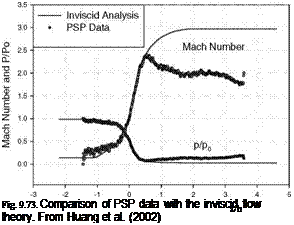Micronozzle
PSP is a molecular sensor that can be used for global pressure measurements in MEMS devices. Huang et al. (2002) used PSP to measure the pressure distribution in a Mach 3 micronozzle fabricated with a high-accuracy CNC machine. Generally, an imaging system for PSP (or TSP) applied to MEMS devices must use an optical microscope and a close-up lens with a CCD camera to achieve a sufficiently high spatial resolution. In experiments, Ru(dpp) was used as a probe luminphore mixed with RTV as the binder dissolved in dichloromethane. Using a CCD camera with a close-up lens, a spatial resolution of 12 |jm was achieved. Figure 9.71 is a schematic of the experimental setup for PSP measurements in a micronozzle. The micronozzle was connected to a vacuum pump, and one valve was used to control pressure at the micronozzle exit and another valve to change the inlet pressure from the atmosphere. Two pressure transducers were used to monitor the pressure signals at the micronozzle inlet and exit. Figure 9.72 shows a schematic of the micronozzle and a typical pressure image in the supersonic regime in the micronozzle where the total pressures at the nozzle inlet was 11.45 psi and the estimated Reynolds number based on the nozzle diameter was about 8000. Figure 9.73 shows a comparison of the PSP data with an inviscid flow solution for local pressure and Mach number. The PSP data are in agreement with the inviscid flow solution in the convergent and throat regions of the nozzle. However, the Mach number obtained by PSP in the downstream region after the nozzle was significantly lower than that predicted by the inviscid flow solution after the Mach number reached 2.5. This discrepancy may be due to the significant boundary-layer growth that was not taken into account in the inviscid flow solution.
Fig. 9.72. (a) Schematic of a micronozzle, and (b) pressure distribution in a micronozzle at the total pressure of 11.45 psi. From Huang et al. (2002)
![]()












